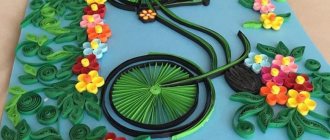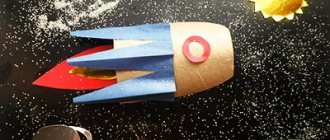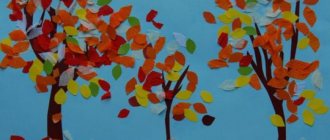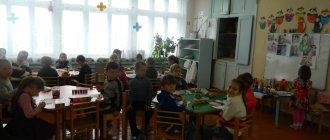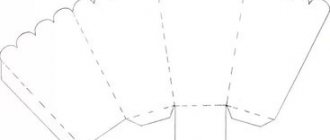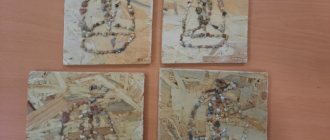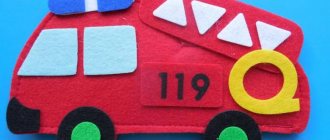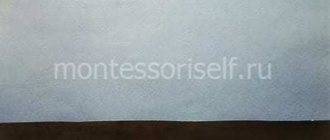Application in the senior group
Table of contents
Introduction
1. The importance of applications in the upbringing and development of a preschool child
2. Applique as a type of fine applied art
3. Application as a type of visual activity in the senior group of preschool educational institutions (program, class topics, materials, equipment)
4. Methods and techniques for teaching application in the senior group
Conclusion
Bibliography
Application
Introduction
One of the types of applied art, where a drawing, pattern or ornament is created by gluing or striping multi-colored pieces of fabric or paper onto the main background, is appliqué.
The originality of the applique lies both in the nature of its image and in the technique of its execution.
The image in the appliqué is highly conventional compared to other types of planar images - drawing, painting. The applique is characterized by a generalized form, almost without details. Most often, a local color without shades is used, and one color differs sharply from another.
Applique is one of the most favorite types of visual arts for children: children are pleased with the bright color of the paper, the good arrangement of the figures, and the technique of cutting and gluing is of great interest to them.
Application as a type of visual activity is aimed at developing certain knowledge in children, developing skills, practicing skills and nurturing personality. Application gives children the opportunity to acquire knowledge about color, the structure of objects, their size, shape and composition.
The purpose of the work is to consider the methodology for teaching application in the senior group.
1.
The importance of application in the upbringing and development of a preschool child
Application is considered a type of artistic activity provided for by the “Program of Education and Training in Kindergarten” for preschoolers. Getting acquainted in classes and independently with materials, techniques and methods of processing paper, children acquire the skills of graphic and plastic representation of objects, master the ability in silhouette form, figuratively, creatively to process their impressions received when getting acquainted with the outside world, while reading fiction, looking at illustrations, paintings, sculptures, works of folk arts and crafts.
Children embody their knowledge, abilities, skills in creative activities: they make colorful wall panels, decorations for tabletop and shadow theaters, costumes and decoration elements for performances and festive matinees, decorations for the kindergarten area, gifts for younger children, parents, etc. [1]
The process of creating an application consists of a number of sequential actions that require the child to have a fairly high level of development of visual and technical skills, as well as concentration, perseverance, endurance, accuracy, and independence.
An insufficient degree of development of technical skills inhibits the work of imagination, fetters children's initiative, and reduces the quality of performance results. And vice versa, if a child is proficient in the techniques of cutting, gluing, and sewing appliqué onto a base, his attention is directed to creating combinations of different shapes, sizes, and colors, which leads to new, original results and stimulates a creative attitude to work. This is possible only when the teacher skillfully regulates and applies the most effective teaching methods in the classroom, when tasks are given not only in ready-made form, but more often require children to actively, creatively, rather than reproductively, use the acquired knowledge and skills.
In classes, preschoolers get acquainted with the properties of different materials (leather, paper, straw, fabric, etc.), learn to distinguish geometric shapes, colors, establish the ratio of parts by size and combine parts into a whole, identify the structure, position of an object in space, orientate on a piece of paper. Every child practically masters the concept of rhythm, symmetry, and harmony.
Children improve their eye function, the ability to evaluate and correct mistakes made through analysis (before fixing the figures on a plane); Speech develops: children master the correct verbal designations of directions (left, right, middle, corners, top, bottom). They learn to group round, rectangular, oblique, polygonal shapes, to correctly name large concepts (long - short, narrow - wide, high - low, more - less, in half, half, four, etc.). Preschoolers purposefully apply this knowledge in practical activities [4].
A big role in the applique belongs to its color design, which has a huge impact on the development of children’s artistic taste. Color has an emotional impact on the baby, captivating him with its colorfulness and brightness. Therefore, it is important to purposefully develop a sense of color as the most accessible idea of the beauty of the surrounding world and works of art.
The teacher must constantly explain to the children why they need to use this or that color for applique, what combinations are suitable for it, in order to most expressively convey a certain content. Using the principle of contrasting color comparison, applications such as “Night”, “Late Autumn”, “Winter”, “Tractors in the Fields” are made. Bright color accents are used in decorative tasks, based on the plots of fairy tales and cartoons [5].
Harmonious combinations made up of similar-sounding tones help convey natural phenomena (“Spring has come,” “First flowers”), create compositions such as bouquets, decorating carpets and fabrics. Children must learn to see beauty and convey it in proportionate forms, rational symmetrical and asymmetrical alternation, and variable interpretation.
In classes, preschoolers master a number of labor skills related to processing material (folding, cutting, gluing), using tools (scissors, glue, brush, etc.). Children must learn to work carefully, systematically, strive to achieve a positive result, overcoming difficulties and making volitional efforts. They develop a work culture (they prepare the necessary materials in advance, put the workplace in order, plan the sequence of tasks, and put away the materials and tools after the lesson).
Children improve and coordinate their hand movements, developing qualities such as accuracy, speed, and smoothness. This becomes possible with the systematic, planned conduct of classes, the organization of independent artistic activities, the consistent implementation of program requirements in each age group, and the gradual complication of tasks as experience is gained. Children must learn to diversify the skills they have acquired in other types of artistic activities (drawing, modeling, design).
In appliqué classes, preschoolers develop the ability to work and create in a team, guided not only by personal interests, but also by the interests of their peers, the content, and the need for joint activities. This involves improving such personality traits of the child as being demanding of oneself and others, taking a responsible attitude towards assigned work, and implementing the principles of consciousness, discipline, mutual assistance and support. Preschoolers get the opportunity to show independence and initiative, and experience the feeling of joy from achieving a positive result through joint efforts.
The level of mastery of the skills and abilities provided for by the application program makes it possible to implement and determine the degree of readiness of each child for successful learning at school, further mastery of the content and techniques of various types of artistic craft.
2. Applique as a type of fine applied art
Applique (from Latin appllcatio - to apply, apply) is one of the types of applied art used for the artistic design of various objects (clothing, furniture, dishes, etc.) by attaching cut-out decorative or thematic shapes to the main background.
The appliqué process involves two steps: cutting out individual shapes and attaching them to the background.
As a means of decoration, appliqué creates a unique decorative effect. Sometimes cut-out shapes are used to decorate a room (for example, paper napkins and lace for decorating shelves, various multi-colored figures for gluing onto glass windows as a festive decoration) [1].
Applique cut-outs from fabric, fur and leather are used to decorate clothes and make panels.
Sometimes the cut out parts are not completely attached to the background, and the applique turns out to be partially voluminous. For example, the petals of a flower are attached only at the middle, and its ends lag behind the background. This gives greater expressiveness to the image. The simplicity and ease of execution of the applique make it accessible to children's creativity. Children can either use ready-made forms, painted in certain colors, or create compositions by cutting out elements of patterns, plot images, etc. Thus, applique classes contribute, on the one hand, to the formation of fine arts and skills, on the other hand, to the development of creative children's abilities.
Preschoolers master all the processes of making appliqué—cutting and gluing shapes. Preparatory exercises for mastering this type of activity are games with mosaics, with the help of which children, laying out ready-made geometric shapes, become familiar with their features, color, arrangement methods, and principles of creating a pattern.
Cutting without gluing helps master the applique process (children cut paper, making tickets, flags, etc. for the game, learn to use scissors).
In kindergarten, they use such types of appliqué work as gluing ready-made forms (decorative - from geometric and plant forms and object - from individual parts or silhouettes) and cutting and gluing forms (individual objects, plot, decorative).
Preschoolers can cut out shapes in sections or as a silhouette. Composing an object from separate parts is easier for them, like any constructive image in drawing or modeling. Silhouette cutting is more difficult for children, since they always need to compare the general contours of the object with the proportions of its individual parts. Therefore, cutting out complex shapes is included in the program only in the preparatory group.
The application contains great opportunities for the development of imagination, imagination, and creative abilities of children. Thus, the pattern can be made up of both ready-made geometric and plant shapes cut out by the children themselves. The use of ready-made forms in decorative works allows preschoolers to focus all their attention on the rhythmic alternation of elements in a pattern and the selection of beautiful color combinations.
Children use the skills acquired in appliqué classes in other activities, mainly in design, making shadow theater, light decorations, and Christmas tree decorations.
For application work, white and colored paper of various types are used. For the background, take thicker paper - white from sketchbooks, colored table paper, thin cardboard. The forms to be glued are cut out of thin paper, preferably glossy. It comes in bright colors and is pleasant to the touch, which is especially important for working with young children.
For classes in the middle and sometimes in the senior group, paper is cut in advance into pieces of a certain size in accordance with the task. For example, for gluing a house, they give a ready-made piece of paper representing the walls; Children cut out a roof from a strip of a different color, etc. This blank will help children maintain its shape and correctly convey the size and proportions of the parts of the house.
For older preschoolers, forms of various colors and shades are used, since in these groups mainly decorative gluing is carried out from geometric shapes according to the children's plans, and they need to be provided with a wide choice of material. The use of shapes of different colors contributes to the manifestation of independence and creativity in work. Children can, if the task allows, choose the color of their choice. Particularly important is the selection of a variety of colored forms and paper in classes, the purpose of which is to independently compose beautiful color combinations.
Thus, the application process requires a fairly large amount of materials and tools, which must be prepared in advance.
3. Application as a type of visual activity in the senior group of preschool educational institutions (program, class topics, materials, equipment)
Children five to six years old are able to master a fairly large amount of skills in appliqué, improve them by cutting and gluing patterns from geometric and plant shapes, objects of simple and more complex shapes and structures, and when performing plot-themed compositions.
Along with cutting out various shapes by eye, children should learn to depict objects by folding a piece of paper in half to convey a mirror image of the right and left sides of Christmas trees, vases, leaves, cupped flowers, butterflies, etc.; repeatedly folding the paper like an accordion, cut out a composition such as a garland, a round dance, where leaves, flowers, nesting dolls, and parsley are evenly repeated (cut out of brightly colored paper with additional stickers, they look elegant in the festive design of a group room, hall, or kindergarten area).
To enhance the expressiveness of some images, the teacher must skillfully use the technique of broken appliqué. So, preschoolers can depict fluffy chickens, soft willow buds, mimosa, dandelion blossoms, clouds.
At the beginning of the school year, you should consolidate the acquired ability to cut out geometric shapes and objects based on the shape of a circle, oval, square, rectangle, triangle in various combinations (balls, balloons, houses, toys, cars).
The objectives of teaching application in the senior group are the following (Kosminskaya V.B.):
- develop the ability to cut using a variety of techniques: straight in different directions, with curves, from paper folded in half;
- develop the ability to compose an object from several parts and arrange patterns on a circle, square, rectangle from geometric and plant shapes;
- use new colors (orange, purple) and various light and dark shades of colors, beautifully combining them in the pattern.
So, the main task in the senior group is to master a variety of cutting techniques that are necessary to depict objects with different shapes [5].
At first, cutting out rectangular and round shapes continues on the same themes as in the middle group, but with a large number of details (a snowman in a hat, with a shovel in his hands, eyes and a nose are outlined on his head; an airplane with stars on the wings, etc. ). Then objects with smaller parts are introduced (chickens, rabbits, etc.).
In this group, children learn to cut out some shapes from paper folded in half, which is required when depicting, for example, a branch with leaves or a hare's ears. Using this technique saves time and allows you to create interesting and expressive compositions.
Cutting an object out of folded paper makes it easier to achieve a symmetrical shape. Mastering this technique is possible only in the older group, as it requires developed perception and analytical thinking, in particular the ability to divide an object into two halves. Using this technique, preschoolers cut out simple shapes - vases, leaves, vegetables and fruits.
applique preschooler learning
In the older group, children become familiar with the technique of creating a shape by tearing off the edges of paper, which makes it possible to convey the features of the texture - the fluffiness of snow, fur.
The development of cutting skills is facilitated by the constantly improving ability of preschoolers to make targeted observations and highlight the characteristic qualities of objects. The topics of children's work are gradually expanding.
4. Methods and techniques for teaching application in the senior group
The main task of teaching appliqué to children of the sixth year of life is to master a variety of cutting techniques. In classes, preschoolers depict objects with different shapes, symmetrical and asymmetrical shapes in a static position or conveying simple movement.
Based on the children's ideas and using nature (or a picture replacing it), the teacher analyzes the structure of the object, isolating individual parts, outlining their forms and noting their relationships with each other.
Since children of this age cannot make small parts, it is recommended to select items with simpler shapes, local colors, and a small number of details. A teddy bear, turned wooden toys, etc. are suitable for this work. The sample is used in the older group in cases where preschoolers depict an object for the first time. But even here, children should be given the initiative in resolving issues of color, size, arrangement of shapes on the sheet, etc.
If children are given the task of depicting an already familiar object with some details, then the sample can be replaced by life or a picture (for example, depict not just a house, but a fairy-tale house or a house decorated for a holiday).
In the senior, and then in the preparatory groups, it is recommended to use several samples more often to show the possibility of different composition options. This fosters creative initiative in preschoolers in completing tasks. For example, children learn the technique of cutting out two halves of Parsley's costume from two pieces of paper folded together. The teacher only shows techniques for cutting out clothes, and when looking at the samples, the children note that Petrushka’s clothes can be of different colors, shapes, and he has different objects in his hands. In decorative works, when making patterns from the same elements, paper in the shape of a circle, square, strip, etc. is used [4]
As a rule, older preschoolers master new techniques based on the teacher’s demonstration.
The most difficult thing for children of this age is cutting out symmetrical shapes from paper folded in half. As already noted, mastering this technique requires developed perception and analytical thinking, in particular, the ability to divide an object into two halves and cut it out.
I.L. Gusarova recommends that when children are first introduced to this technique, they cut out shapes along a pre-drawn outline on paper folded in half. Often a child cannot imagine that the result will be a beautifully shaped vase or jug. When children realize that the drawn outline represents half of the object, they will be able to cut it out by eye, using the teacher’s demonstration and explanation.
In the older group, some application works (for example, “Aquarium with fish”, “Flowers in the meadow”, “Houses and cars on the street”) are performed by children collectively. Each child performs a specific part of the composition. All parts are subsequently united against a common background [3].
The teacher distributes work among children in accordance with their wishes.
To complete some tasks (“Fish in an aquarium”, “Birds in a tree”), preschoolers are united in subgroups of 4-5 people. Frieze compositions (“Houses and cars on the street”, “Boats on the river”) are performed by the whole group.
Conclusion
Appliqué is one of the types of visual techniques based on cutting, overlaying various shapes and fixing them on another material taken as the background. The concept of “appliqué” includes methods of creating works of art from materials that differ in their properties and texture, united by the similarity of the execution technique. Each material has its own characteristics, which have a decisive influence on the application technique.
The experience children gain in drawing up subject or plot images using ready-made forms ensures the development of imaginative vision, as well as the formation of prerequisites for plot drawing and speech development at later age stages.
Applique classes, when used correctly with age-appropriate methods and techniques, not only entertain, but also educate and develop.
Bibliography
1. Gusakova M.A. Application. - M.: Education, 1987. - 289 p.
2. Ignatiev E.I. Psychology of children's visual activity. - M.: Uchpedgiz, 1961. - 223 p.
3. Komarova T.S. Methods of teaching visual arts and design. - M., Education, 1991 - 369 p.
4. Komarova T.S., Sakulina N.P. Visual activities in kindergarten. - M.: Education, 1982. - 305 p.
5. Kosminskaya V.B., Khalezova N.B. Fundamentals of fine arts and methods of guiding children’s visual activities: Laboratory workshop: A textbook for students of pedagogical institutes. - M.: Education, 1987. - 388 p.
6. Sakulina N.P., Komarova T.S. Visual activities in kindergarten. - M., 2001.
7. Friel K. Artistic creativity and the child / Under. ed. Vetlugina. - M.: Education, 1972. - 256 p.
Application
Approximate long-term lesson plan for application in the senior group (September-December)
| Month | Lesson topic | Program tasks | Material | Preparation for class | Teaching Techniques |
| September | Beautiful pattern (as intended) | Reinforce the techniques of cutting out geometric elements and making patterns, combining colors and compositions (independently, creatively) | Multi-colored paper. White background. Geometric blanks (circles, squares, stripes) | Look at the ornamented objects. Highlight the features of their decoration | Instructions for making the pattern. Encouraging children's independence and creative exploration |
| September | Fruits | Learn to convey the shape and color of an orange, plum, melon, watermelon, comparing them in pairs by size and color (to choose from) | Blanks of corresponding colors. White background | Examination of the basic properties of fruits | Reinforcing techniques for cutting circles and ovals from squares and rectangles |
| September | Vegetables (from nature) | Learn to cut the real shape of a cucumber, carrot, beet, etc. with tops and leaves | Preparation of colored paper. White background | Examine the basic properties of vegetables | Demonstration of techniques for cutting out objects with characteristic features |
| September | Truck | Learn to convey the shape, location of the main parts; stick carefully. Provide the ability to choose paper color | Stripes of different colors. Blue background | Consider trucks of different brands. Select the main structural parts, their shape, color | Securing the sequence of cutting and pasting shapes |
| October | Trucks carry the harvest of vegetables and fruits (teamwork) | Learn to determine the content of the application, carry it out jointly and creatively, establishing relationships between different objects; enjoy the results of collective activity | Blue background, strips of colored paper of different sizes | Conduct a conversation about harvesting on collective and state farms. Use illustrations | Explanation of the task. Help in distributing work. Activating children's independence |
| October | Decorate the apron with a pattern | To develop the ability to decorate the silhouettes of aprons with elements of a geometric pattern using folk ornament motifs (to choose from); beautifully combine colors, use different patterns | Background: silhouettes of white, red and other colors. Strips of paper of different colors for a pattern | Organize exhibitions of products made by folk craftsmen. Look at the patterns | Showing options for decorating aprons with geometric patterns. Encouraging children's creativity |
| October | Bus | Learn to cut out the main parts of the bus silhouette; convey their magnitude and color relationships | Stripes of different colors. White background | Consider a bus, compare with a truck | Consolidating techniques for cutting out parts and the sequence of gluing them |
| October | Multi-storey building | Learn to convey the structure and parts of a house of modern architecture by combining rectangles of different sizes and colors | Stripes of different colors and sizes | On a walk, consider the features of houses, their structure, differences in height, decoration elements | Demonstration of application techniques. Activation of children, reliance on their past experience, level of knowledge and skills |
| November | Garland of leaves (collectively) | Learn to cut out autumn leaves from a rectangle by folding it in half, holding it by the fold. Develop the ability to create a garland from individual colorful leaves to decorate a room | Stripes of yellow, red, orange, green colors | Organize a conversation | Demonstrating a technique for cutting out symmetrical leaf shapes. Reinforcing the techniques of sequential folding and cutting out of paper |
| November | Bouquet of leaves in a vase (from life) | Secure the technique of cutting out leaves and vases by folding the piece of paper in half. Make a beautiful bouquet using combinations of bright shapes with a blue background | Multi-colored stripes and a rectangle for a vase. Blue background | Consider a bouquet made of autumn leaves | Reinforcing the technique of cutting leaves. Leading children to use the same technique to depict a vase, modifying the configuration of the object |
| November | Street (collectively) | Strengthen the ability to depict multi-story buildings, types of urban transport and place silhouettes on a plane. Be able to agree on the content and sequence of task completion | Multi-colored paper for appliques and background design | Organize a walk down the street; consider houses standing in a row, different types of transport | Instructions on the procedure for completing the task, assistance in its distribution, selection of material |
| December | Merry tumblers | Learn to cut circles more accurately, measure them in size, combine them in color to convey an expressive image of the toy | Colored stripes. White background. Tumbler dolls | Organize games with tumblers (leave them in the play corner) | Examination of toys, explanation of techniques for performing the selected toy |
| December | Fairytale house in the forest between the fir trees | Learn to creatively implement a theme. Teach the ability to cut out Christmas trees by folding the workpiece in half; freely place the cut out shapes on the sheet, combining them by color | Colored paper. Blue background | Look at the illustrations showing different versions of fairy-tale houses in winter decoration | Demonstration of the technique of cutting out Christmas trees by folding a rectangle in half. Encouraging children's creativity |
| December | Mittens for the Snow Maiden | Learn to cut out various pattern elements and decorate with them the silhouettes of mittens cut out of multi-colored paper. Develop creativity | Strips of colored paper. Mitten silhouettes | Bring and examine colored mittens decorated with colorful patterns | A proposal to decorate the silhouettes of mittens yourself, beautifully choosing the shapes and colors of the elements. Encouraging creative exploration and results |
| December | Decorated Christmas tree | Learn to carve a Christmas tree and decorations for it (balls, garlands, animals) using familiar techniques. Learn to create bright and elegant decorations. Create joyful anticipation of the holiday | Green rectangle for the Christmas tree. Scraps of colored paper | Decorate the Christmas tree on the site with colorful toys and flags | Reinforcing the technique of cutting a Christmas tree. Activating children's creativity in the process of decorating it. Encouragement of successful works, selection of samples for exhibition |

